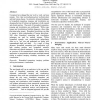Free Online Productivity Tools
i2Speak
i2Symbol
i2OCR
iTex2Img
iWeb2Print
iWeb2Shot
i2Type
iPdf2Split
iPdf2Merge
i2Bopomofo
i2Arabic
i2Style
i2Image
i2PDF
iLatex2Rtf
Sci2ools
107
click to vote
IEEEPACT
2003
IEEE
2003
IEEE
Biomedical Computing and Visualization
Computers have changed the way we live, work, and even recreate. Now, they are transforming how we think about and treat human disease. In particular, advanced techniques in biomedical computing, imaging, and visualization are changing the face of biology and medicine in both research and clinical practice. The goals of biomedical computing, imaging and visualization are multifaceted. While some images and visualizations facilitate diagnosis, others help physicians plan surgery. Biomedical simulations can help to acquire a better understanding of human physiology. Still other biomedical computing and visualization techniques are used for medical training. Within biomedical research, new computational technologies allow us to “see” into and understand our bodies with unprecedented depth and detail. As a result of these advances, biomedical computing and visualization will help produce exciting new biomedical scientific discoveries and clinical treatments. In this paper, we give an ...
Biomedical Computing | Biomedical Scientific Discoveries | Biomedical Simulations | Hardware | IEEEPACT 2003 |
| Added | 04 Jul 2010 |
| Updated | 04 Jul 2010 |
| Type | Conference |
| Year | 2003 |
| Where | IEEEPACT |
| Authors | Chris Johnson |
Comments (0)

